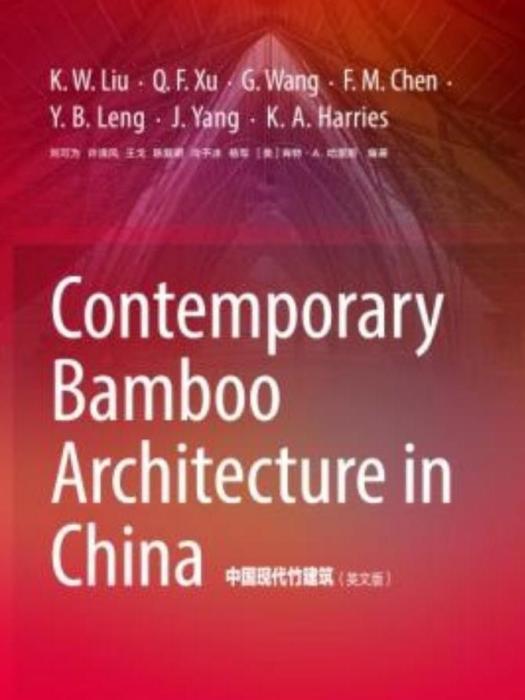《Contemporary Bamboo Architecture in China (中》是2022年清華大學出版社出版的圖書,作者是劉可為、許清風、王戈、陳復明、冷予冰、楊軍、[美]肯特.A.哈里斯。
基本介紹
- 中文名: Contemporary Bamboo Architecture in China (中
- 作者:劉可為、許清風、王戈、陳復明、冷予冰、楊軍、[美]肯特.A.哈里斯
- 出版時間:2022年
- 出版社: 清華大學出版社
- ISBN: 9787302580218
- 定價:168 元
內容簡介,圖書目錄,
內容簡介
作為首部系統展示中國現代竹建築設計和建造重要進展的英文讀圖文集,本書系統梳理了竹材在建築工程領域的套用現狀和**研究成果,極大增進了行業交叉融合,啟發從業者積極主動、大膽地選擇可愛的竹子來建設人類美麗家園。本書通過100多個典型案例、350多張高清建築美圖,從建築用竹裝飾材、建築用竹結構材、景觀配置、交通設施、輸水管道和城市綜合管廊五個方面,生入淺出而又趣味生動地展示了中國現代竹建築發展歷程和成果,充分體現了竹建築的文化內涵和科技成果。為全球竹建築相關研究、設計和施工人員,“一帶一路”竹產業政策和標準制定者,發展理念超前的開發商,以及對竹建築感興趣的國際讀者提供了參考。
圖書目錄
Contents
1 Distribution of Bamboo Forest Resources and Species
for Construction 1
1.1 Chinese and Global Markets for Bamboo Structural Products 4
References 5
2 Types and Characteristics of Bamboo Materials
for Construction Uses 7
2.1 Structure and Morphology of Bamboo 8
2.2 Bamboo as a Load-Bearing Structural Material 9
2.2.1 Full-Culm Bamboo 9
2.2.2 Engineered Bamboo 15
2.3 Bamboo as Enclosure and Decoration Materials 19
2.3.1 Bamboo Flooring 19
2.3.2 Indoor Bamboo Decorative Materials 20
2.4 Bamboo in Other Structural Load-Bearing Applications 22
2.4.1 Bamboo Scaffolding 22
2.4.2 Bamboo-Reinforced Concrete Structures 23
2.4.3 Bamboo-Reinforced Masonry Structures 24
2.4.4 Application of Bamboo Bars in Soil Reinforcement
Engineering 24
2.4.5 Application of Bamboo in Strengthening of Existing
Structures 25
References 26
3 Research and Development Status of Different Types
of Bamboo Structures 31
3.1 Full Culm Bamboo Structures 31
3.1.1 Research Status of Full Culm Bamboo Structures 43
3.1.2 Summary of Full Culm Bamboo Structures 46
3.2 Engineered Bamboo Structures 46
3.2.1 Research Achievements in Engineered Bamboo
Structures 53
27
28 Contents
3.2.2 Summary of Engineered Bamboo Structures 55
References 55
4 Standards 59
4.1 International Standards 59
4.2 Chinese Bamboo Standards 62
References 69
5 International Organizations, Research Institutions,
and Production and Processing Enterprises in China 71
5.1 International Organization 71
5.2 Research Institutions 72
5.2.1 Bibliographic Analysis Methodology 72
5.2.2 Findings 72
5.3 Production and Processing Enterprises 75
References 78
6 Case Studies 79
6.1 Bamboo as Decorative Materials 80
6.2 Bamboo as Structural Materials 123
6.3 Landscapes 200
6.4 Rural Construction 232
6.5 Transport Facilities 245
6.6 Water Pipelines and Urban Municipal Tunnels 255
References 260
7 Opportunities and Challenges for the Modern Bamboo
Construction Industry in China 261
7.1 Advantages for Competition 261
7.1.1 Resources and Material Advantages 261
7.1.2 Industrial and Technological Advantages 263
7.1.3 The Advantage of Eco-culture Value 264
7.2 Disadvantages for Competition 264
7.2.1 Inadequate Basic Research 264
7.2.2 Inadequate Penetration of Automation in Bamboo
Processing Industries 265
7.2.3 Lack of Standardisation 265
7.2.4 Lack of Capacity-Building for Professionals 266
7.3 Opportunities 266
7.3.1 Support by National Policies 266
7.3.2 Towns with Local Characteristics and Revitalization
of Rural Areas 267
7.4 Threats 267
7.4.1 The Rising Cost of Labour 267
7.4.2 Low Public Awareness of Bamboo Architecture 268
7.4.3 Risk in Bamboo Enterprises 268
7.5 Summary 269
References 269

